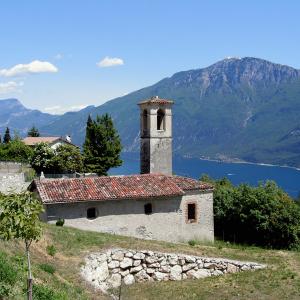Ustecchio is located just four kilometers from the lake, between Voltino and Bazzanega, at an altitude of 490 meters above sea level.
Signs of the Roman period
The name derives from the Latin "ustus", meaning burnt or arid, with the suffix "-ecchio", which in turn derives from the Latin "iculus", small. The medieval village is probably a Roman settlement, as some archaeological findings reveal.
Along the provincial road in Mure, there is a commemorative monument that includes a Roman plaque dating back to the 1st century AD. On the same monument there is also a fresco, integrated into a wayside shrine, dedicated to the Virgin Mary, Queen of Peace.
Following the road that branches off from the shrine, you can reach Ustecchio di Sopra, the main part of the village. Near the church dedicated to Sant'Antonio Abate, along the main road that leads to the plateau, there is a small group of houses that form Ustecchio di Sotto.
The Church of Sant'Antonio Abate and its orientation
The village church, dedicated to Sant'Antonio Abate, was built over a 60-year period starting in 1564; it was finished in 1620. The only aisle is divided by an arch that also supports the roof of the building at the same time. The peculiarity of this church is its orientation, thoroughly debated before its construction - the building was designed specifically so that worshippers are facing the rising sun, a symbol of Christ.
The wayside shrine with the Caravaggio Madonna
Ustecchio is full of churches and frescoes, such as the one located at the intersection between Via Etruschi and Via Erti. In the small historic centre of the place called Pozza, there is a decorated shrine with a fresco dating back to 1668, dedicated to Our Lady, protector of sinners. The Caravaggio Madonna is still visible, even though the fresco is no longer in perfect condition. It was probably an ancient shrine dedicated to San Cristoforo.
The patron saint’s day in Ustecchio is celebrated on January 17th.





